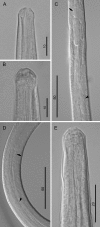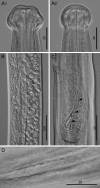Intraperitoneal development of the filarial nematode Brugia malayi in the Mongolian jird (Meriones unguiculatus)
- PMID: 24664084
- PMCID: PMC4544663
- DOI: 10.1007/s00436-014-3829-5
Intraperitoneal development of the filarial nematode Brugia malayi in the Mongolian jird (Meriones unguiculatus)
Abstract
In the present study, we describe intraperitoneal development of the FR3 strain of Brugia malayi in Mongolian jirds (Meriones unguiculatus). The third molt for male worms occurred between 4 and 7 days postinfection (dpi) and between 4 and 8 dpi for females. The fourth and final molt occurred between days 21 and 29 for males and 25 and 34 for females, considerably earlier than the times reported for subcutaneous infection models using cats and jirds. The timing of the third molt coincided largely with reports for subcutaneous Brugia pahangi infections of cats and jirds, but the final molt occurred considerably later and lasted longer than those reported for subcutaneous B. pahangi models. Spermatogenesis occurred by at least 50 dpi in adult males, and insemination of females likely occurred between 50 and 60 dpi. Microfilariae were observed in the uteri and ovejectors of adult females at 65 dpi.
Figures







References
-
- Buckley JJ. On Brugia gen. nov. for Wuchereria spp. of the ‘malayi’ group, i.e., W. malayi (Brug, 1927), W. pahangi Buckley and Edeson, 1956, and W. patei Buckley, Nelson and Heisch, 1958. Ann Trop Med Parasitol. 1960;54:75–77. - PubMed
Publication types
MeSH terms
LinkOut - more resources
Full Text Sources
Other Literature Sources
Miscellaneous

